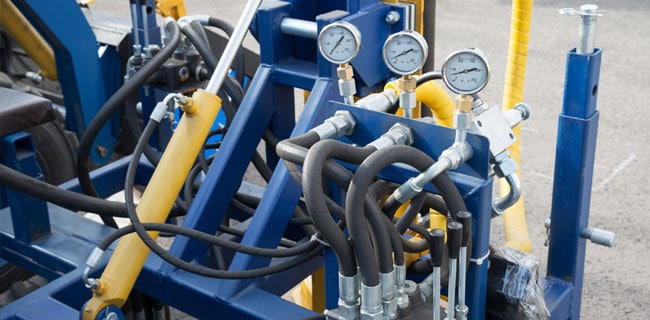Have you ever experienced hydraulic hose failure and thought “Great, how am I going to fix this quickly so I can get back to work?”
You’re not alone. Hydraulic hose failure can cause production to come to a grinding halt and is often caused by abrasion, material erosion, improper assembly, fluid incompatibility, high temperatures or simply wear and tear. Hydraulic hose failure not only slows production, but it can also be dangerous, especially if the hose contains flammable fluids or hazardous material. High-pressure hoses can also inject hydraulic fluid into parts of the body if exposed. Other dangers of hydraulic hose failure include:
- Slip and fall risks
- Explosions
- Fluid burns
- Bursting under pressure
The key to getting your operation back up and running is to understand the different parts of the hydraulic hose assembly and how they work together in harmony.
CONTACT US TODAY TO DISCUSS YOUR NEEDS OR TO SCHEDULE AN ONSITE CONSULTATION AT 314-638-6500 OPTION 4.
Dissecting Hydraulic Hose Assembly Components

The Hydraulic Hose
Hydraulic hoses are ideal solutions for conveying fluid through various equipment and applications. They should be able to withstand a wide range of operating pressures and provide high levels of abrasion resistance, durability, and excellent performance.
Hydraulic hoses are comprised of three components:
- Tube: The tube within the hose is the inner-most portion of the hose and conveys various media from one end of the hose to the other.
- Reinforcement: The reinforcement of the hose is the intermediate layers between the tube and the cover, which provides strength to the hose assembly. Reinforcements can include material that is braided, spiral or helical in nature.
- Cover: The cover of the hose protects both the intermediate reinforcement layer and the tube inside from external conditions.
In the event of hydraulic hose failure, you’ll want to be sure to select the correct hose for the application. You can often refer to the manufacturer guidelines for this step, or, you can check the markings that run along the length of the hose. (If the correct hose was used initially.)
The Hydraulic Hose Fittings
Hydraulic hose fittings are the weakest links in your hose assembly and must be carefully selected based on the specific requirements of the application. Hydraulic hose fittings are typically made out of metal and have two important components: the socket and the stem. The socket is the part of the fitting that goes on the outside of the hose cover. The stem goes in the inner tube of the hose and connects the hose to other components. Manufacturers recommend using matched sets of hoses and fittings for optimal performance and safety. To avoid dangerous and expensive leaks, choose fittings with these considerations in mind:
- Fluid compatibility
- Potential risks and hazards
- Temperature and pressure ratings
- Installation design
- Hose size
- Corrosions requirements
Related: Pro Tips for Proper Selection of Hydraulic Hose End Connections
Select the Right Hydraulic Fittings for the Application.

The two main categories of hydraulic hose fitting attachment styles are: permanent crimp fittings and field attachable fittings. Permanent crimp fittings require a crimping machine to attach the hose to the fitting, while field attachable fittings require only a wrench and a vise to attach the hose to the fitting.
There are many different types of fitting end connections on the market and choosing the right one for your industrial application can be challenging. At a minimum, your hydraulic hose assembly should hold up against high temperatures, high pressures and high levels of abrasion in just about any industrial hydraulic application.
Let’s explore these common types of end connection fittings:
- Joint Industrial Conference Fitting (JIC) is the most common hydraulic connection type and has parallel threads and a 37° cone on the end that can attach to a flared tube or hose fitting.
- National Pipe Threads Fittings (NPT) are among the oldest traditional tapered thread fittings and have been on the market for 100 years. This connection style is often used in pneumatic and process systems as well as hydraulic systems.
- Four-Bolt Flange Fittings are time-tested, leak-free connections that conform to SAE J518 and ISO 6162-1 and -2 standards. Ideal for larger sizes, higher pressures, or assembly in tight quarters.
- Inch Compression Fittings are bite type fittings for hydraulic tubing but are limited in the variations of hose connection options. It can be used in the field with minimal tooling required for attachment.
- O-Ring Face Seal Fittings (ORFS) can eliminate leaks in many hydraulic applications and instrumentation systems. Because they create a rubber-like seal that is essentially leak-proof, these fittings are efficient in eliminating leaks in high-pressure applications and preventing component failure. ORFS fittings can be used in static applications such as hoses conveying fluids and also in dynamic applications like rotating pump shafts and pistons.
- O-Ring Boss Fittings (ORB) incorporate a port connection that is recommended by the National Fire Protection Association (NFPA) for leak prevention in medium and high-pressure hydraulic systems. ORB fittings are often made from carbon, nickel-plated carbon or stainless steel. The seal is created when the O-ring is compressed into the chamfer when the male and female connections are mated.
Related: Industrial Hose Maintenance: How to Inspect for Wear Points on Your Hose Assembly
Learn More About Superior Industrial Supply’s On-Site Hose Repair
Superior Industrial Supply understands your industrial and hydraulic hose needs and how efficient repairs are critical to your business’ success. To help you get back to work quickly, we can place a hose crimping machine on-site, complete with bulk hose and hose ends. We also offer training on fast and effective hose repair when you need it most.
We carry everything you need for your hydraulic hose assemblies from top-rated brands like Eaton Weatherhead. If you have questions on how Superior can help you improve operations and extend the life of your hydraulic hose assemblies, stop into our St. Louis location, or call 314-638-6500 OPTION 4.

